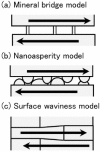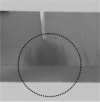The toughening mechanism of nacre and structural materials inspired by nacre
- PMID: 27877460
- PMCID: PMC5090675
- DOI: 10.1088/1468-6996/12/6/064710
The toughening mechanism of nacre and structural materials inspired by nacre
Abstract
The structure and the toughening mechanism of nacre have been the subject of intensive research over the last 30 years. This interest originates from nacre's excellent combination of strength, stiffness and toughness, despite its high, for a biological material, volume fraction of inorganic phase, typically 95%. Owing to the improvement of nanoscale measurement and observation techniques, significant progress has been made during the last decade in understanding the mechanical properties of nacre. The structure, microscopic deformation behavior and toughening mechanism on the order of nanometers have been investigated, and the importance of hierarchical structure in nacre has been recognized. This research has led to the fabrication of multilayer composites and films inspired by nacre with a layer thickness below 1 μm. Some of these materials reproduce the inorganic/organic interaction and hierarchical structure beyond mere morphology mimicking. In the first part of this review, we focus on the hierarchical architecture, macroscopic and microscopic deformation and fracture behavior, as well as toughening mechanisms in nacre. Then we summarize recent progress in the fabrication of materials inspired by nacre taking into consideration its mechanical properties.
Keywords: composites; mechanical properties; multilayers; nacre; toughening mechanism.
Figures












References
-
- Meyers M A, Chen P-Y, Lin A Y-M. and Seki Y. Prog. Mater. Sci. 2008;53:1. doi: 10.1016/j.pmatsci.2007.05.002. - DOI
-
- Weiner S. and Addadi L. J. Mater. Chem. 1997;7:689. doi: 10.1039/a604512j. - DOI
-
- Jackson A P, Vincent J F V. and Turner R M. Proc. R. Soc. 1988;234(B):415. doi: 10.1098/rspb.1988.0056. - DOI
Publication types
LinkOut - more resources
Full Text Sources
